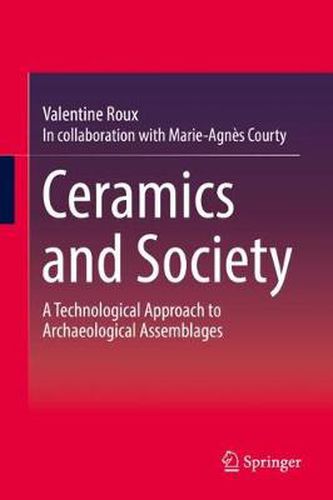Readings Newsletter
Become a Readings Member to make your shopping experience even easier.
Sign in or sign up for free!
You’re not far away from qualifying for FREE standard shipping within Australia
You’ve qualified for FREE standard shipping within Australia
The cart is loading…






This title is printed to order. This book may have been self-published. If so, we cannot guarantee the quality of the content. In the main most books will have gone through the editing process however some may not. We therefore suggest that you be aware of this before ordering this book. If in doubt check either the author or publisher’s details as we are unable to accept any returns unless they are faulty. Please contact us if you have any questions.
Pottery is the most ubiquitous find in most historical archaeological excavations and serves as the basis for much research in the discipline. But it is not only its frequency that makes it a prime dataset for such research, it is also that pottery embeds many dimensions of the human experience, ranging from the purely technical to the eminently symbolic.
The aim of this book is to provide a cutting-edge theoretical and methodological framework, as well as a practical guide, for archaeologists, students and researchers to study ceramic assemblages. As opposed to the conventional typological approach, which focuses on vessel shape and assumed function with the main goal of establishing a chronological sequence, the proposed framework is based on the technological approach. Such an approach utilizes the concept of chaine operatoire, which is geared to an anthropological interpretation of archaeological objects.
The author offers a sound theoretical background accompanied by an original research strategy whose presentation is at the heart of this book. This research strategy is presented in successive chapters that are geared to explain not only how to study archaeological assemblages, but also why the proposed methods are essential for achieving ambitious interpretive goals.
In the heated debate on the equation stating that pots equal people , which is a rather fuzzy reference to assumed relationships between (mostly) ethnic groups and pottery, technology enables us to propose with conviction the equation pots equal potters . In this way, a well-founded history of potters is able to achieve a much better cultural and anthropological understanding of ancient societies.
$9.00 standard shipping within Australia
FREE standard shipping within Australia for orders over $100.00
Express & International shipping calculated at checkout
This title is printed to order. This book may have been self-published. If so, we cannot guarantee the quality of the content. In the main most books will have gone through the editing process however some may not. We therefore suggest that you be aware of this before ordering this book. If in doubt check either the author or publisher’s details as we are unable to accept any returns unless they are faulty. Please contact us if you have any questions.
Pottery is the most ubiquitous find in most historical archaeological excavations and serves as the basis for much research in the discipline. But it is not only its frequency that makes it a prime dataset for such research, it is also that pottery embeds many dimensions of the human experience, ranging from the purely technical to the eminently symbolic.
The aim of this book is to provide a cutting-edge theoretical and methodological framework, as well as a practical guide, for archaeologists, students and researchers to study ceramic assemblages. As opposed to the conventional typological approach, which focuses on vessel shape and assumed function with the main goal of establishing a chronological sequence, the proposed framework is based on the technological approach. Such an approach utilizes the concept of chaine operatoire, which is geared to an anthropological interpretation of archaeological objects.
The author offers a sound theoretical background accompanied by an original research strategy whose presentation is at the heart of this book. This research strategy is presented in successive chapters that are geared to explain not only how to study archaeological assemblages, but also why the proposed methods are essential for achieving ambitious interpretive goals.
In the heated debate on the equation stating that pots equal people , which is a rather fuzzy reference to assumed relationships between (mostly) ethnic groups and pottery, technology enables us to propose with conviction the equation pots equal potters . In this way, a well-founded history of potters is able to achieve a much better cultural and anthropological understanding of ancient societies.